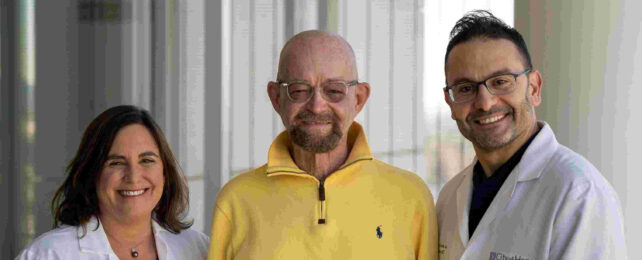On the list of illnesses that nobody wants, cancer and HIV both rank pretty high, and Californian man Paul Edmonds had both.
But ever since one particular treatment five years ago, he's been free of both cancer and HIV. The patient is now considered in remission from acute myelogenous leukemia (AML), and in another two years, he could be considered 'cured' of HIV, as that will mark five years from his last treatment.
To celebrate, the medical team behind his astonishing recovery have published a letter describing the case in the New England Journal of Medicine.
The treatment behind the remission is known as a stem cell transplant, or, in medical terms, an allogeneic hematopoietic cell transplantation.
It's used as the final part of treatment for blood cancers like leukemia, myeloma and lymphoma, where the blood-forming stem cells in a patient's bone marrow have been destroyed by radiation or chemotherapy. Healthy blood-forming stem cells from a donor with similar (but not identical) genes are transplanted into the patient, where they can begin to produce cancer-free blood.
In this case, the doctors report, the donated stem cells came with an added benefit: a genetic mutation associated with resistance to HIV-1.
Edmonds had lived with HIV-1 for 31 years before the transplant.
"People were dying within a few years of finding out they were positive," Edmonds said, describing his experiences in San Francisco in the 80s. "A dark cloud was over the city."
He was diagnosed in 1988 with HIV and full-blown AIDS, which at that time, he told the national cancer institute, City of Hope, felt like a death sentence.
Edmonds had been on HIV antiretroviral therapy since 1997, which had effectively suppressed the virus to undetectable levels.
But antiretroviral therapy doesn't cure HIV, so the virus's DNA was ever-present in his immune cells in his blood - that is, until his cancer treatment introduced a different kind of DNA to his system.
The stem cells Edmonds received in his transplant had two copies of a rare genetic mutation called CCR5 delta-3, which makes people who have it resistant to HIV. Only about 1-2 percent of the population have this mutation, but a donor match for Edmonds with the mutation was found via the City of Hope's blood stem cell and bone marrow transplant program.
HIV uses the receptor CCR5 to enter and attack the immune system, but the CCR5 mutation means the virus can't enter through this pathway.
The transplant totally replaced Edmonds' bone marrow and blood stem cells with the donors', and ever since, he's shown no signs of either AML or HIV. He is one of only five people in the world to have ever gone into HIV remission from this treatment.
After the transplant, the HIV DNA that his blood cells once harbored was nowhere to be found. Edmonds agreed, for science's sake, to discontinue his HIV treatment 25 months after the transplant, which would have led to a resurgence of HIV RNA in his blood, if the virus was still present.
"At the time of this follow-up, the patient had been free of HIV-1 infection for 35 months after the discontinuation of antiretroviral therapy," the doctors write.
"This case has shown that older patients who are undergoing reduced-intensity conditioning HCT for the treatment of cancer may be cured of HIV-1 infection."
Stem cell transplants come with substantial risks, so not all people living with HIV will be able to receive this treatment. It's still only viable for those with life-threatening blood cancers, with the possibility of curing HIV as a bonus.
Jana Dickter, a doctor at City of Hope involved in Edmonds' case, hopes others will benefit from this two-for-one treatment in future.
"For those who would benefit from a stem cell transplant to treat their cancer, the idea that they could go into remission from HIV simultaneously is amazing," she says.
The letter was published in The New England Journal of Medicine.
